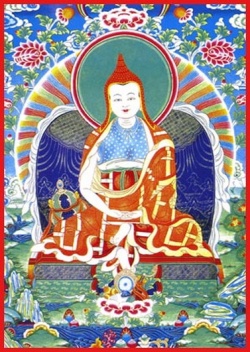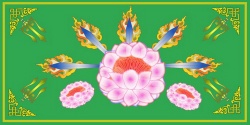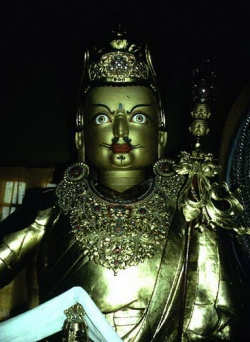Preliminaries To Buddhist Tantra
- "Tantra activates many powerful subtle energies in our body and mind and,
- if we do not have any mental training or discipline,
- this excess energy will take the path of least resistance
- through our negative emotions of attachment, jealousy, pride, egotism, and so on"
- Lama Ganchen
Secrecy
- "Pure intellect, indeed, detached from soul, is the death of Man. Intellect, self-confident and isolated in arrogant complacency, does not ennoble Man. It humiliates him, deprives him of his personality. It kills that loving participation in the life of things and creatures of which the soul, with its emotions and intuitions, is capable. Intellect, by itself alone, is dead and also deadly - a principle of disintegration."
From Giuseppe Tucci's "The Theory and Practice of the Mandala" - Rider.
Why are Buddhists so secretive of tantra? Tantric practice is a highly advanced form of psycho-physical exercises in order to achieve transformation of one's body and mind quickly into the perfected state of a Buddha. Simply said, these methods are not without danger when used without the proper guidance and precautions. To avoid people getting involved in these practices without proper guidance, the practices are kept secret for people without explicit permission to practice from a qualified teacher. Often, teachers require disciples to do extensive practices before being allowed any permission; more about that is written in below paragraphs on prerequisites and preliminaries. So please keep in mind that the secrecy around tantra is basically for safety, just like it is proper to lock a gun away from the reach of children. Whatever is included on these web pages about tantra is general knowledge which is allowed for uninitiated to read, and is intended to at least take away some misunderstandings about tantric practices.
Motivation For Practice
To clarify where tantric practices fit in the Buddhist system, it may be useful to explain a bit more about the various motivations or scopes. Traditionally, only the "small, middle and high scope" are taught to distinguish the various motivations for practising. Here, I would like to present a somewhat unconventional approach, starting even below spiritual practice:
- - The "Animal Scope": Wanting immediate happiness for oneself.
- - The "Worldly Human Scope": Wanting immediate happiness for oneself and others.
- - The Buddhist Small Scope: Wanting happiness for oneself in a future life.
- - The Buddhist Middle Scope: Wanting to escape the cycle of uncontrolled rebirth for oneself. (Hinayana)
- - The Buddhist Great Scope: Wanting others to go beyond suffering forever (enlightenment), and reach Buddhahood oneself to help others on their path. (Mahayana)
- - The "Buddhist Tantric Scope": Wanting others to be happy as soon as possible, and reach Buddhahood oneself quickly to serve them. (Vajrayana)
A teaching from "Being Peace" by Thitch Nhat Hahn:
- "A woman who practices reciting Buddha Amitabha's name, is very tough and recites "NAMO AMITABHA BUDDHA" three times daily. Although she is doing this practice for over 10 years, she is still quite mean, shouting at people all the time. She starts her practice lighting incense and hitting a little bell.
- A friend wanted to teach her a lesson, and just as she began her recitation, he came to her door and called out: "miss Nuyen, miss Nuyen!".
- As this was the time for her practice she got annoyed, but she said to herself: "I have to struggle against my anger, so I will just ignore it." And she continued: "NAMO AMITABHA BUDDHA, NAMO AMITABHA BUDDHA..."
- But the man continued to shout her name, and she became more and more oppressive.
- She struggled against it and wondered if she should stop the recitation to give the man a piece of her mind, but she continued reciting: "NAMO AMITABHA BUDDHA, NAMO AMITABHA BUDDHA..."
- The man outside heard it and continued: "Miss Nuyen, miss Nuyen..."
- Then she could not stand it anymore, jumped up, slammed the door and went to the gate and shouted: "Why do you have to behave like that? I am doing my practice and you keep on shouting my name over and over!"
- The gentleman smiled at her and said: "I just called your name for ten minutes and you are so angry. You have been calling Amitabha Buddha's name for more then ten years now; just imagine how angry he must be by now!"
Prerequisites
The following aspects are considered prerequisites before a disciple can engage in tantric practice:
- 1. Refuge in the Buddha, Dharma and Sangha.
- 2. Renunciation: a realisation is best, but a proper understanding is essential.
- 3. Bodhicitta: a realisation is best, but a proper understanding is essential. For most of the initiations, it is required to take the aspiring Bodhisattva vows or the Bodhisattva vows.
- 4. Emptiness: a direct realisation is best, but a proper understanding is essential (see the page on Wisdom).
- 5. Reliance on a spiritual teacher: proper confidence in a teacher and verifying his/her qualifications is essential.
- 6. Empowerment or initiation: without this ceremonial permission to practice by a qualified teacher, tantric practice is improper.
- 7. Tantric vows: for the higher tantric classes, one needs to take tantric vows. These vows are secret to the uninitiated, so students need to take 'a leap of faith' and trust the teacher and the practice before taking them.
- 8. Faith/confidence: solid confidence both in the teacher and the teachings is essential to avoid serious karmic problems when doubts arise. 'Blind faith' will generally not have the power to pull someone through when things are difficult.
The only proper motivation to practice tantra is bodhicitta, or the wish to become fully enlightened in order to help all sentient beings. This is the reason why at least an understanding of bodhicitta is essential prior to engaging in tantric practice. To enforce this motivation, usually, an extra prerequisite is taking either the Aspirational Vows or the full Bodhisattva Vows. Next, at least some understanding of the philosophy of emptiness is essential for tantric practice, as this is the basic mental state in which tantric practice becomes more than just ritual or strange practice of imagination. Ideally, a tantric practitioner should have full realisations of bodhicitta and emptiness instead of merely a conceptual understanding. In that case, tantric practice can guide one very swiftly to the state of Buddhahood.
Preliminary Practices
Some teachers (depending on the specific tradition and individual student) require one to engage in the so-called preliminary practices before giving initiation to disciples. However, the first four practices mentioned below (mandala offerings, refuge, Vajrasattva and prostrations) are generally the preliminaries for a traditional "3-year and 3 month retreat". These preliminary practices traditionally consist of :
- - Making 100,000 mandala offerings to generate merit by generosity; (see instruction on the Osel Shen Phen Ling website)
- - Reciting 100,000 refuge prayers (to increase one's confidence, see the page on refuge)
- - Reciting 100,000 Vajrasattva mantras to purify obstacles (see Teachings on the Vajrasattva Retreat by Lama Zopa Rinpoche)
- - Making 100,000 prostrations to counteract pride (see image on the right, and read a description by Sakya Pandita).
Depending on the teacher and the disciple, other practices are sometimes done:
- - Offering 100,000 water-bowl offerings (create merit by generosity)
- - Reciting 100,000 Guru's name mantras: Guru-yoga, to generate confidence and establish a deeper relationship with the teacher
- - Making 100,000 clay images or 'tsa-tsas' in Tibetan (see picture)
- - Reciting 100,000 Samayavajra mantras (somewhat similar to Vajrasattva)
- - Making 100,000 fire offerings to Vajra Daka (Dorje Khadro).
Not only are these excellent methods to accumulate the necessary positive energy (karma) to have success with the practice, but they also help in the purification of obstacles to the practice.





